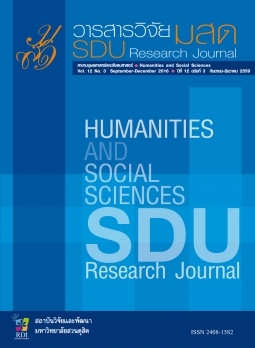รูปแบบการเสริมสร้างความเข้มแข็งของชุมชนโดยวิทยาลัยชุมชน
Keywords:
Model, Community Strength, Community CollegeAbstract
This research aimed to: 1) study and analyze the current states, problems and
obstacles as well as roles in enhancing the community strength; 2) analyze and synthesize
the concepts and elements for enhancing the strength of the domestic and international
community; and 3) to propose a model for enhancing the community strength by the
community colleges. The sample included 47 community college administrators, 4 senior
experts of community colleges, 233 persons engaged in the community colleges and 14
senior experts who assessed the suitability of the (draft) model. The results revealed the
following. 1) The concerned persons viewed that, in the overall picture, all aspects of the
current state of community strength enhancement were at the highest level, except the
aspect of village philosophers and community leaders, which was at a high level.
Obstacles and problems of management, personnel and coordination networks were
found; 3 aspects of roles were based on the targets, missions and education management.
2) The elements for enhancing the community strength were the existence of common
goals, community learning, community participation, coordination networks, community
competence, geo-social capital and community management. 3) The model for enhancing
the community strength by the community colleges comprised the principles, objectives,
elements and roles for enhancing the community strength, work principles and conditions
for success.
References
(ฉบับที่ 2) พ.ศ. 2545 พร้อมกฎกระทรวงที่เกี่ยวข้อง และพระราชบัญญัติการศึกษาภาคบังคับ
พ.ศ. 2545. กรุงเทพฯ: องค์การรับส่งสินค้าและพัสดุภัณฑ์.
กล้า ทองขาว. (2556). การจัดการศึกษาฐานชุมชน (Community-based Education Management =
CBEM). สืบค้น 16 มิถุนายน 2558. จาก http://www.dpu.ac.th/ces/
download.php?filename=1377584927.docx.
ฐากูร ปาละนันท์ และคณะ. 2555. แรงจูงใจในการปฏิบัติงานของบุคลากรสังกัดวิทยาลัยชุมชน. วารสาร
วิจัย มสด สาขามนุยศาสตร์และสังคมศาสตร์, 8(2), 13 – 28.
ถาวร งามตระกูลชล. (2559). การปกครองท้องถิ่น : บทเรียนชุมชนเข้มแข็งประเทศญี่ปุ่น (Local
Government: Lesson of Community Strength of Japan). การประชุมวิชาการระดับชาติ
มหาวิทยาลัยราชภัฏนครปฐม ครั้งที่ 8. มหาวิทยาลัยราชภัฏนครปฐม จังหวัดนครปฐม ระหว่าง
วันที่ 31 มีนาคม-1 เมษายน 2559.
นวลน้อย ตรีรัตน์ และคณะ. (2551). โครงการจัดทำแผนยุทธศาสตร์และรูปแบบการจัดตั้งวิทยาลัยชุมชน.
กรุงเทพฯ: จุฬาลงกรณ์มหาวิทยาลัย.
ปาริชาต สถาปิตานนท์ และชัยวัฒน์ ถิระพันธุ์. (2546). สื่อสารกับสังคมเครือข่าย. กรุงเทพฯ: สถาบันชุมชน
ท้องถิ่นพัฒนา.
ปราโมทย์ ไม้กลัด. (2554). ‘ในหลวง’ ทรงแนะยึดหลักเข้าใจ-เข้าถึง-พัฒนา. สืบค้น 14 มิถุนายน 2558.
จาก http://www.thairath.co.th/content/196644.
ดิเรก พรสีมาและคณะ. (2553). รายงานการวิจัยการกระจายอำนาจการบริหารและการจัดการศึกษาสู่เขต
พื้นที่การศึกษาและสถานศึกษา. กรุงเทพฯ: สำนักงานเลขาธิการสภาการศึกษา.
พรชุลี อาชวอำรุง. (2539). การพัฒนาและการทำงานกับรายการในฐานะเทคนิคการเรียนการสอนเพื่อส่ง
เสริมการคิดวิเคราะห์. กรุงเทพฯ: จุฬาลงกรณ์มหาวิทยาลัย.
วิจิตร ศรีสอ้าน. (2518). หลักการอุดมศึกษา. กรุงเทพฯ: ไทยวัฒนาพานิช.
สถาบันวิทยาลัยชุมชน. (2558). พระราชบัญญัติสถาบันวิทยาลัยชุมชน พ.ศ. 2558. สืบค้น 4 มิถุนายน
2558. จาก http://library2.parliament.go.th/giventake/content_nla2557/law30-
100458-1.pdf.
สำนักงานคณะกรรมการการอุดมศึกษา. 2557. คู่มือการประกันคุณภาพการศึกษาภายในสถานศึกษา ระดับ
อุดมศึกษา พ.ศ. (2557). กรุงเทพฯ: ห้างหุ้นส่วนจำกัดภาพพิมพ์.
สำนักงานคณะกรรมการพัฒนาการเศรษฐกิจและสังคมแห่งชาติ. 2554. แผนพัฒนาเศรษฐกิจและสังคมแห่ง
ชาติ ฉบับที่ 11 (พ.ศ. 2555-2559). สืบค้น 17 มีนาคม 2555. จาก http://www.
nesdb.go.th/Default.aspx?tabid=395 [2555, มีนาคม 17].
สุนันทา แสงทอง. (2551). การศึกษาการใช้หลักธรรมาภิบาลในวิทยาลัยชุมชน. ต้นกล้าชุมชน. 4(30), 6-8
Bartle, P. (2012). Sixteen Elements of Community Strength. Retrieved September 1, 2013,
from http://cec.vcn.bc.ca/cmp/modules/mea-16.htm.
Department of Planning and Community Development. (2011). Indicators of Community
Strength in Victoria: Framework and Evidence. Retrieved May 6, 2012, from
http://www.dpcd.vic.gov.au.
Krippendorff, K. (1980). Content Analysis: An Introduction to its Methodology. London:
Sage.
Scottish Community Development Centre. (2012).
Retrieved July 25, 2015, from https://www.wyndham.vic.gov.au/generic.
Translated Thai References
Achava-Amrung, P. (1996). Development and Working with Status of Techniques in
Learning and Teaching to Promote Critical Thinking. Bangkok: Chulalongkorn
University. (in Thai)
Bartle, P. (2012). Sixteen Elements of Community Strength. Retrieved September 1, 2013,
from http://cec.vcn.bc.ca/cmp/modules/mea-16.htm.
Commission on Higher Education. (2014). Guidelines for Quality Assurance in Higher
Education Academic Year 2014. Retrieved July 14, 2015, from http://www.
mua.go.th/users/bhes/ QAMUA58/qa%20manual58/QA_MANUAL30032558.pdf.
(in Thai)
Department of Planning and Community Development. (2011). Indicators of Community
Strength in Victoria: Framework and Evidence. Retrieved May 6, 2012, from
http://www.dpcd.vic.gov.au.
Institute for Community Colleges. (2015). Institute for Colleges Act B.E. 2558. Retrieved
June 14, 2015. http://library2.parliament.go.th/giventake/content_nla2557/
law30-100458-1.pdf. (in Thai)
Krippendorff, K. (1980). Content Analysis: An Introduction to its Methodology. London:
Sage.
Maikad, P. (2011). King Rama IX His Suggested of Principle for Understanding Accessibility
and Development. Retrieved June 14, 2015, from http://www.thairath.co.th/
content/196644. (in Thai)
Ministry of Education. (2003). National Education Act B.E. 2542 (1999) and Amendment
[Second National Education Act B.E. 2545 (2002)]. Bangkok: Printing Press, Express
Transportation Organization. (in Thai)
National Economic and Social Development Board. (2011). Eleventh National Economic
Development Plan (2012-2016). Retrieved July 25, 2015, from http://www.
nesdb.go.th/Default.aspx?tabid=395. (in Thai)
Ngarmtrakulchol, T. (2016). Local Government: Lesson of Community Strength of Japan.
The 8th NPRU National Academic Conference, Nakhon Pathom Rajabhat
University, Nakhon Pathom, Thailand, March 31, 2016: 1-25. (in Thai)
Palanan, J., Skulkhu, J. & Suthummaraksa, S. (2012). Job Motivation of Community College
Personnel. SDU Research Journal Humanities and Social Sciences, 8(2), 13 – 28.
(in Thai)
Pornsima, D. (2010). Research Report on Decentralization of Educational Administration
and of Management Schools and Education Service Area. Bangkok: Office of the
Education Council, Ministry of Education. (in Thai)
Scottish Community Development Centre. (2012). Building Stronger Communities.
Retrieved July 25, 2015, from https://www.wyndham.vic.gov.au/generic.
Sangthong, S. (2008). A Study of the Principles of Good Governance in the Community
College. Tonkra Chumchon, 4(30), 6-8. (in Thai)
Sthapitanon, P. & Thirapan, C. (2003). Communication and Network Society. Bangkok: Local
Development Community Institute. (in Thai)
Srisa-arn, V. (1975). Principles of Higher Education. Bangkok: Thai Watana Panich
Press Co., Ltd. (in Thai)
Thongkao, K. (2014). Community-based Education Management. Retrieved June 16, 2016,
from http://www.dpu.ac.th/ces/download.php?filename=1377584927.docx.
(in Thai)
Treerat, N. et al. (2008). The Project of Strategic Planning and Model of Establishing
Community College. Bangkok: Chulalongkorn University. (in Thai)







